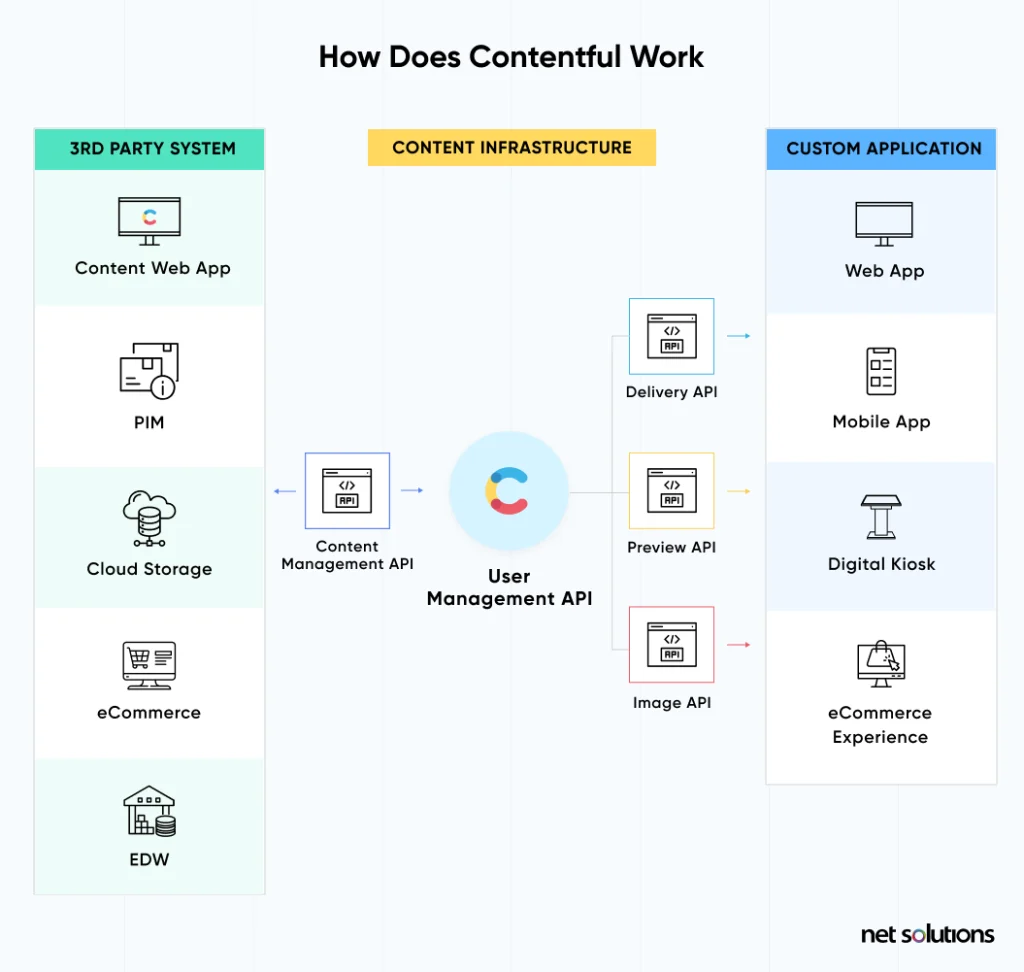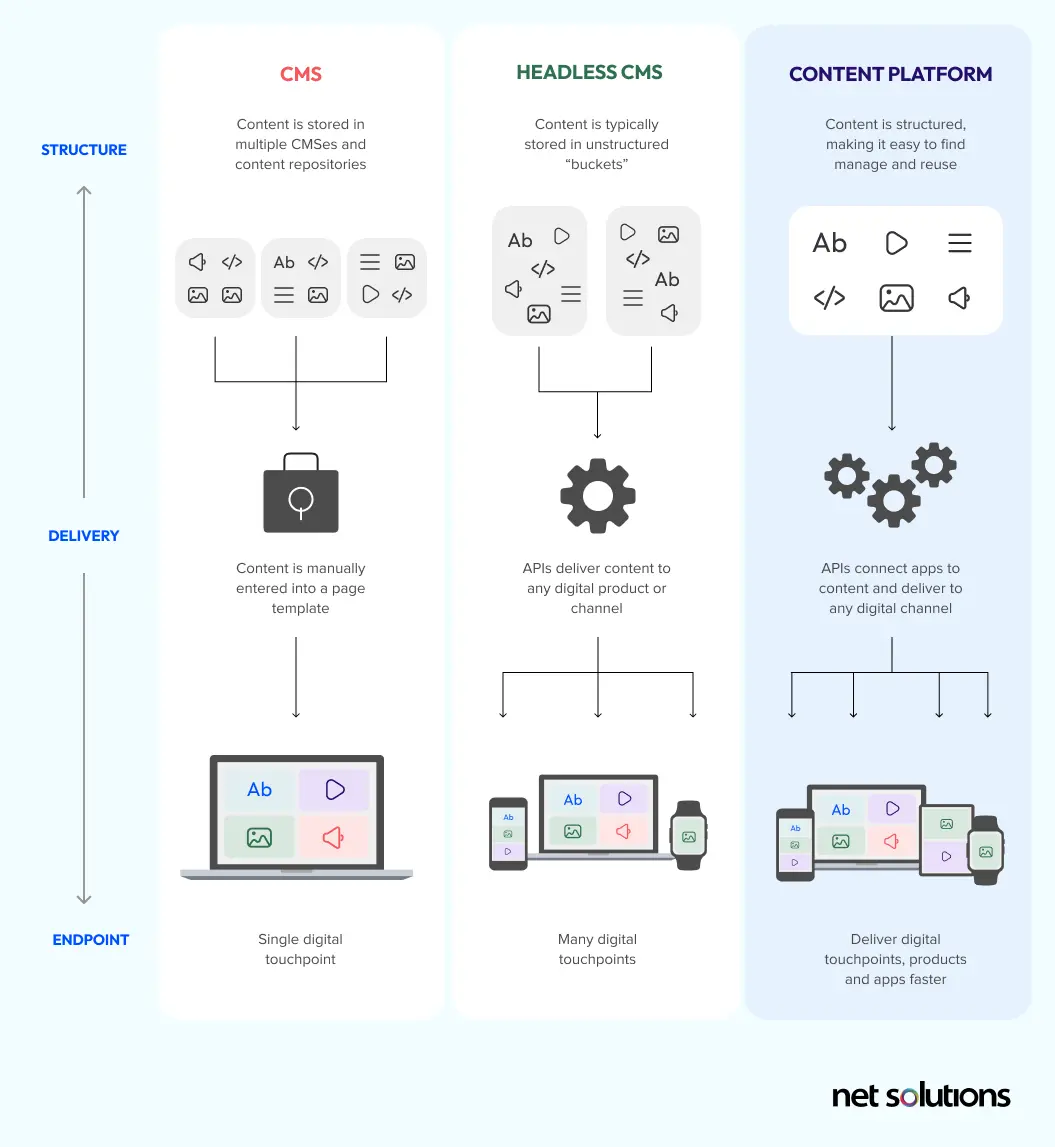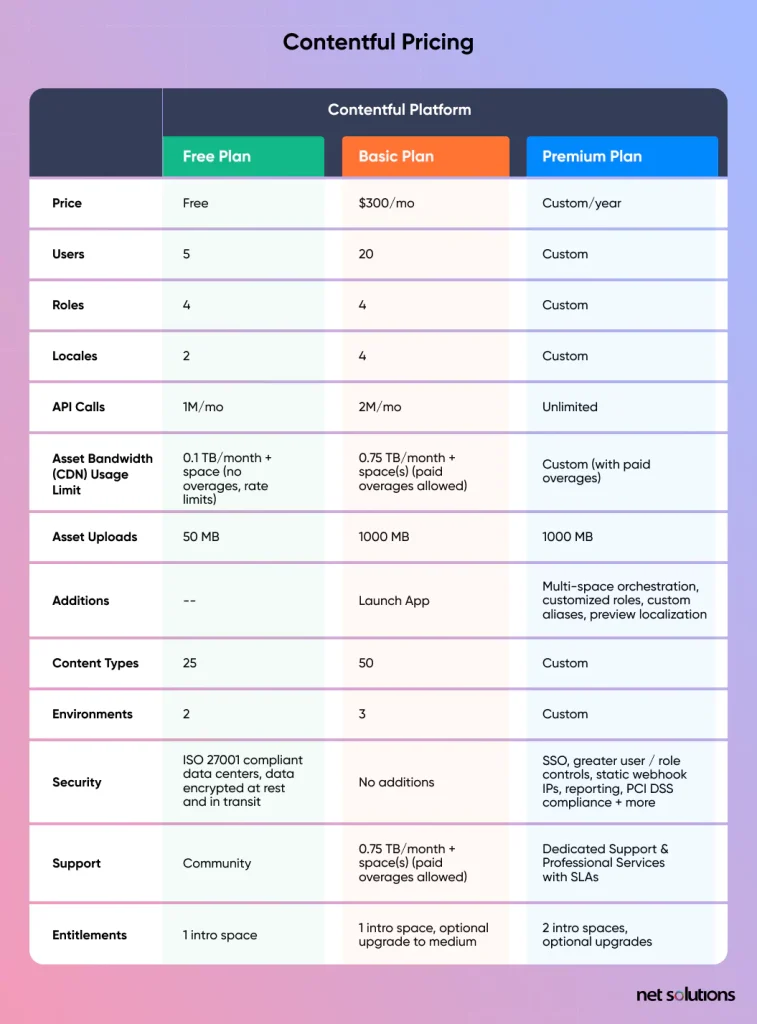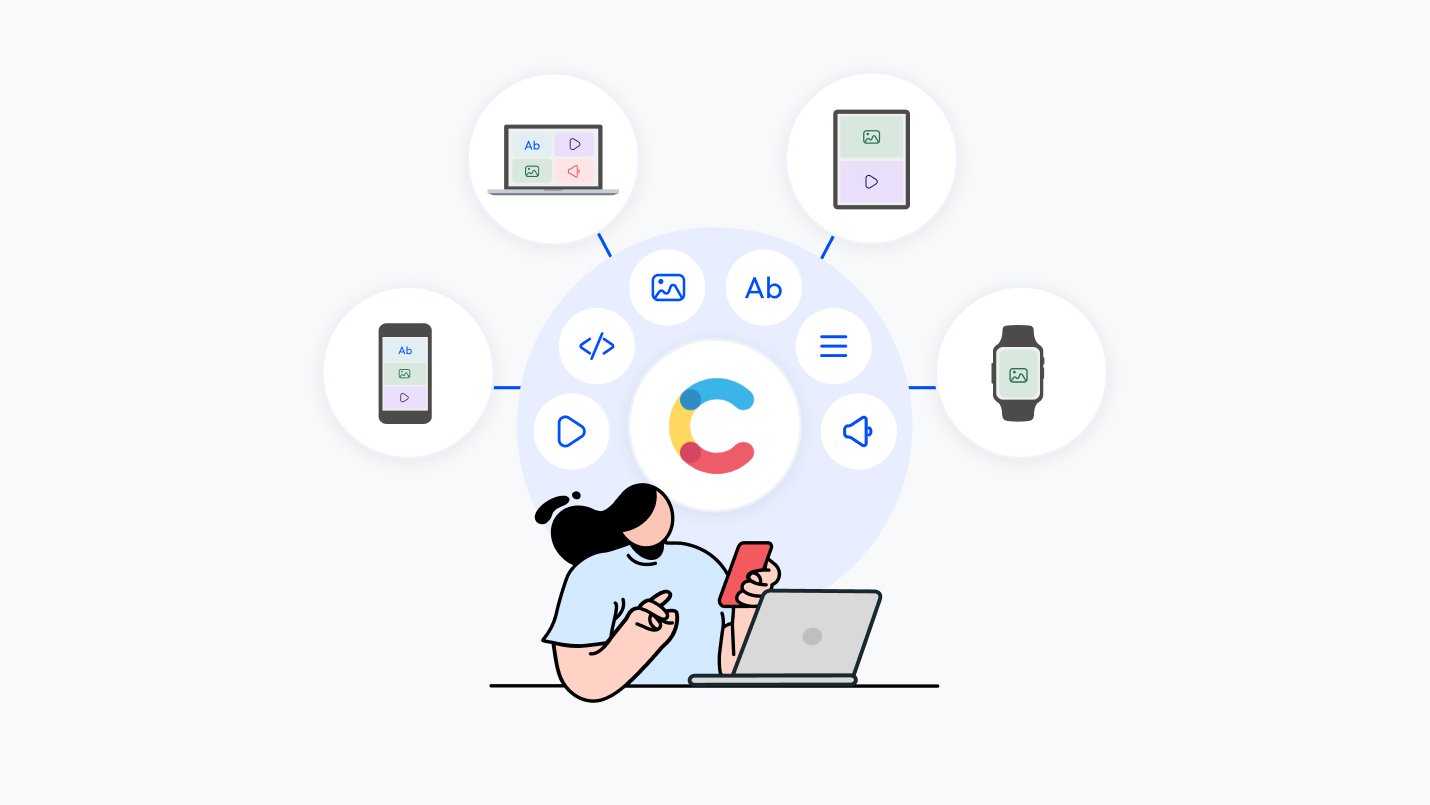Content powers every aspect of the modern digital experience, shaping how businesses engage with their audiences across platforms and devices. This guide provides a comprehensive overview of Contentful to help you evaluate whether it’s the right content platform for your business needs. Inside, you’ll discover:
- How a headless or composable CMS is critical to deliver highly personalized customer experiences.
- The key features of Contentful and why they matter in today’s competitive environment.
- How to know when Contentful is the best choice for your website and commerce needs — and when it might not be.
- Step-by-step guidance on how to get started with Contentful.
Let’s dive in and explore how Contentful can transform the way you deliver digital experiences!
Chapter 1: The Headless Approach — Why It Matters
A content management system — a CMS — is a platform used to create, manage and publish digital content. While traditional platforms focused on web content, the reality today is that digital content is consumed across many digital channels — apps, social media, and smart devices to name a few. And if you want that content to look good anywhere, and to personalize experiences to better connect with your customers, you need a headless CMS.
A headless CMS decouples the front-end (presentation) layer from the back-end (content repository). By removing the tight coupling of the traditional CMS platforms, businesses can quickly adapt to emerging technologies, deliver content to any channel without extensive rework, and future-proof their digital infrastructure with a more scalable solution. When each individual component of the system is also decoupled — each frontend or “head,” and each service of the backend — headless is further evolved into a composable CMS.
Going headless or composable enables businesses to:
- Deliver Content Everywhere: Publish content simultaneously to each front-end — websites, apps, wearables, smart devices, social platforms, and more — helping you realize your omnichannel strategies.
- Leverage Reusable Content: Make content reusable across brands, regions and channels.
- Customize Content Experiences: Create an optimized experience for each channel and platform.
- Enable Developer Freedom: Developers can build custom front ends using any framework or language with only a single content repository to manage.
- Future-Proof Tech Stack: Leverage an API-first architecture to adapt to new technologies, customer preferences, and emerging channels without rebuilding the CMS.
Read this eBook to learn how businesses can assess their composable architecture and understand the value of their technology stack.
In the next section, we’ll examine how Contentful, a leading composable CMS, revolutionizes content management by powering content teams with tools to accelerate time to market and deliver highly targeted content at scale with minimal developer support.
Chapter 2: How Does Contentful Work?
Contentful was a pioneer in headless CMS, helping supporting businesses to reach their customers in an evolving technology landscape. Driven by continuous innovation, Contentful is now a leading intelligent composable content solution, trusted by 30% of Fortune 500 companies to help bring experiences to market in record time.
A traditional CMS creates content for the web. Still, it may not be optimized for other use cases like smartphones or smart watches or new social media sales opportunities, leading many companies to have multiple CMS implementations – which is expensive and complex to keep organized.
For modern businesses that want to deliver optimized experiences across channels but have one single shared repository, the solution is a headless CMS like Contentful.
This video is very helpful to give you an overview of Contentful solutions:
The Contentful platform unifies content (new and from external systems), using powerful content modeling to make content easy to reuse across brands, channels, and regions. You simply define content — like text, images, videos, or references — and how you want content to look in certain scenarios — like product pages or blog posts. In turn, developers set up the supported channels — web, app, social media, etc — using the frameworks and languages of their choice, with many helpful starter templates to accelerate projects.
Once the content model is set up, content teams can independently create and deliver new experiences to anywhere and everywhere — no developers required. What may have taken days (or weeks) is stripped back to just minutes. Whether you’re creating a new blog post, launching a new product, engaging on a new social platform, or expanding to new markets, Contentful is designed to flex and scale to your needs.

Chapter 3: Features of Contentful
Contentful packs an extensive suite of features tailored for technical and non-technical users. Its API-first architecture allows seamless integration into any front-end framework — letting developers build custom interfaces — and back-end services to future-proof the tech stack while also empowering marketing and content teams to manage content using an intuitive web interface.
Key features of Contentful:
- A structured content model and taxonomy to make content easy to reuse and personalize with AI tools.
- Powerful tools for marketers and content editors such as Live previews, a visual builder (‘Contentful Studio’), real-time collaboration tools, and intelligent automation to support content generation.
- Ninetailed by Contentful, an integrated no-code personalization engine that empowers marketers to build, test, and optimize personalization at scale.
- Enterprise support for multi-brand, multi-product experiences across channels and regions, including robust localization features essential for global brands looking to maintain consistent branding worldwide.
- Governance tools such as role-based permissions help teams collaborate without stepping on each other’s toes, along with guardrails to define which elements can be changed and which cannot.
- SDKs, starter templates, webhooks, and a powerful App Framework to fully customize your tech stack.
- Contentful’s API-first architecture and extensive partner network are built for growth, agility, and innovation.

Chapter 4: Benefits of Contentful
Contentful brings agility, scalability, and omnichannel readiness to the table.
First, Contentful’s flexible content modeling means you can structure any content type — blog posts, product listings, or user guides — as a template that accelerates the creation of new experiences. But one step further, Contentful encourages reusability — using existing pieces of content such as images, product descriptions, or quotes — to quickly pull together new content, all without diving into code or reaching out to developers for help. Contentful also ensures these components remain up to date wherever they are used — that every reference to a product description is updated automatically as product details change or products are retired.
Second, Contentful’s robust API and headless architecture ensure content can appear anywhere: websites, apps, chatbots, and even Internet-of-things (IoT) devices. This level of reuse lowers maintenance overhead and preserves brand consistency across channels.
Third, Contentful offers localization features, letting you manage multi-language content from a single hub, giving you control over what content is localized and in which situations.
Finally, developer-centric tools (like SDKs, GraphQL support, and webhooks) streamline integrations, speeding up new feature launches and agility to changing opportunities.
Whether you’re focused on eCommerce, content marketing, or global brand management, Contentful’s modular and future-proof design can be a game-changer.
Chapter 5: Who Should Use Contentful?
Contentful boasts an impressive client roster, supporting over 38K+ websites, including 30% of Fortune 500 companies such as KraftHeinz, KFC, DocuSign, Ruggable, Vodafone, and BMW. It currently powers over 4,000 organizations ideally suited for organizations of any size — from small businesses to enterprise clients — and serves the needs of all its users — developers, marketers, and content creators.
Global retailers rely on Contentful to manage product listings and promotions across eCommerce sites and mobile apps; media and publishing houses benefit from streamlined editorial workflows, ensuring updates can be made quickly, but with reviews as required; SaaS and tech companies use it to power global websites, knowledge bases, blogs, and marketing pages in a unified system that speeds content creation and cuts waste from processes.
Contentful’s headless architecture is beneficial if you have numerous brands and touchpoints, like in-store screens, wearable integrations, global websites, apps, or social shopping. Marketers, content editors, and developers can collaborate in parallel, with each role leveraging tailored interfaces and workflows. Its robust localization, security, and scalability features appeal to enterprise-level teams juggling complex requirements.
Chapter 6: Personalizing Customer Journeys Through Composable Content
Personalization is a powerful driver of customer engagement, and Contentful’s composable content approach enables mid-sized enterprises to deliver tailored experiences efficiently. Rather than siloing content in rigid structures, structured content breaks down web content into its parts: building “blocks” — such as product descriptions, image captions, or promotional banners — that can be rearranged and repurposed across multiple experiences and channels. This flexibility reduces duplication, ensures information remains up to date, and ensures consistent branding and messaging wherever customers interact with your organization. This composable methodology also supports localization efforts, automatically rolling out changes to every channel whenever a core content block is updated — be it a “Featured Product” module for eCommerce or a specialized informational block for global audiences.
By leveraging Ninetailed by Contentful, Contentful customers gain access to a fully integrated personalization engine that can help create, test, and optimize entire customer journeys — not just elements. With Ninetailed, dynamic content delivery becomes seamless: easily defined segments, A/B testing, and real-time updates let you fine-tune what each user sees based on browsing behavior, location, or user preferences. Audience segmentation becomes more intuitive as you can build targeted campaigns from reusable elements, customizing only the pieces that vary by audience segment or campaign goal. From compelling content for your target audience to assisting segmentation, Contentful’s AI Suggestions take personalization to new levels.
Ultimately, merging personalization with composable content yields a scalable, future-proof framework that helps marketing, eCommerce, and technology teams respond quickly to evolving customer needs while sustaining a cohesive brand presence across all digital touchpoints. Contentful’s headless architecture, composable content, and integrations make it a powerful tool for delivering tailored experiences that drive engagement and loyalty.
Chapter 7: Overcoming Common Contentful Challenges: Expert Fixes and Best Practices
While Contentful’s flexibility is an asset, it can overwhelm newcomers used to more straightforward, monolithic CMS platforms such as WordPress or HubSpot — both developers and end-users. In particular, getting the content model right is essential to success on Contentful, both in terms of the content pipeline, developer workload, as well as overall site performance.
Overall, many of the challenges businesses face can be overcome with more up-front planning, especially if you have large teams, complex workflows, or complex integrations with other systems. While Contentful is designed for performance at scale, serving up 110B+ API calls per month, how the content model is structured — and how CDNs and queries are managed — can impact load times, particularly for massive traffic spikes or vast volumes of content.
Chapter 8: Driving Sales and Conversions with Contentful’s Capabilities
Driving sales hinges on converting website visitors into paying customers. To see success in Conversion Rate Optimization (CRO), you need to deliver the right content to the right audience at the right time, ensuring it resonates, looks great, and loads quickly — anywhere it’s viewed.
The combination of headless architecture and Ninetailed by Contentful helps you optimize user experience across channels and test and optimize personalization journeys that drive results — such as the 7x increase in CTR that Ruggable realized on its Black Friday personalization with Contentful.
Chapter 9: Understanding Contentful’s Pricing: A Transparent Overview
Contentful offers a tiered, usage-based pricing model that scales with your business. Small teams or individual projects can start on a free plan, which is ideal for learning the ropes. As you grow, paid tiers unlock more content tools, higher API call allowances, and advanced features like localization and custom roles.

At the enterprise level, Contentful provides custom pricing, including dedicated support, service-level agreements (SLAs), and premium add-ons such as advanced security or Contentful Studio. Monitoring your usage (like API calls and storage) is essential to avoid unexpected costs. Many teams set up usage dashboards or alerts to monitor spending.
Chapter 10: Measuring Success: Key Metrics to Track with Contentful
Tracking key performance indicators helps you gauge the effectiveness of your Contentful deployment. Important metrics include:
- Content Delivery Time: How fast your content loads across devices and geographies.
- API Response Time: The speed at which Contentful’s APIs deliver or accept data.
- Content Reuse Rate: How often you repurpose content blocks across different channels, reflecting efficiency.
- Time to Publish: The average time between content creation and going live, is crucial for agile campaigns.
- Uptime & Reliability: Ensuring Contentful remains consistently accessible to both your team and end users.
Monitoring these metrics helps identify bottlenecks or areas for optimization, whether you’re refining workflows or scaling to meet global traffic demands.
Chapter 11: Contentful vs. Competitors: Making the Right Choice
When looking at CMS options, several contenders appear: Sanity, Prismic, Contentstack, Sitecore, AEM, Webflow, WordPress, Storyblok, and Strapi, among others.
Contentful stands out for its robust enterprise features, mature ecosystem, and highly flexible content modeling. In contrast, platforms like Sanity and Prismic offer simpler UIs that might be easier for smaller teams but can be less feature-rich at scale. Webflow and WordPress provide design-led experiences but may lack some of Contentful’s advanced omnichannel capabilities. AEM and Sitecore are enterprise heavyweights, though they often come with higher price tags and steeper learning curves.
Ultimately, your choice depends on team size, development needs, and growth plans.
Checkout the table below for an overview:
|
Prismic vs. Contentful |
Prismic and Contentful are both top-tier headless CMS platforms, each offering flexible content modeling and straightforward API integrations. Discover their scalability, pricing, and user experience differences in our in-depth comparison: Prismic vs. Contentful. |
|
Strapi vs. Contentful |
Strapi emphasizes open-source flexibility, while Contentful stands out with enterprise-level features and a strong developer ecosystem. Compare their customization options and support structures here: Strapi vs. Contentful. |
|
Sitecore vs. Contentful |
Sitecore offers an all-in-one digital experience platform, whereas Contentful is a headless CMS with dynamic content capabilities. Learn how they stack up in functionality and personalization: Sitecore vs. Contentful. |
|
Contentstack vs. Contentful |
Contentstack and Contentful deliver powerful headless solutions for enterprise-level content management. Compare their collaboration tools, extensibility, and workflow features here: Contentstack vs. Contentful. |
|
Webflow vs. Contentful |
Webflow offers a design-first approach with built-in hosting, while Contentful provides a flexible headless CMS for complex content operations. Uncover which one suits your needs best: Webflow vs. Contentful. |
|
AEM vs. Contentful |
Adobe Experience Manager (AEM) is a comprehensive digital experience platform, whereas Contentful focuses on agility and multichannel content delivery. Explore their key differences and business benefits: AEM vs. Contentful. |
|
Drupal vs. Contentful |
Drupal is a long-standing open-source CMS with extensive community support, while Contentful is built for modern, API-driven development. Delve into their architectures, scalability, and ease of use: Drupal vs. Contentful. |
|
Contentful vs. WordPress |
WordPress dominates traditional CMS setups, yet Contentful’s headless approach offers flexibility for omnichannel experiences. See how they differ in ease of use and customization: Contentful vs. WordPress. |
|
Storyblok vs. Contentful |
Storyblok has a visual editor for a more intuitive workflow, while Contentful emphasizes a structured, API-centric approach. Learn which platform can streamline your content operations: Storyblok vs. Contentful. |
|
Contentful vs. Sanity |
Sanity’s real-time collaboration and flexible schema design contrast with Contentful’s mature ecosystem and enterprise-ready features. Compare how both handle scalability, customization, and ease of integration: Contentful vs. Sanity. |
Chapter 12: Navigating Migration to Contentful: Strategies for a Smooth Transition
Migrating to Contentful requires careful planning to ensure a smooth transition. Follow these steps:
- Audit Existing Content: Review your current CMS to identify what content to migrate, retire, or restructure.
- Develop a Content Model: Plan and build a structured content model that reflects your business needs and future scalability.
- Plan Integrations: Identify third-party tools or systems to integrate with Contentful using APIs and connectors.
- Data Mapping: Align content fields in your current system with the Contentful content model to ensure consistency.
- Test and Validate: Before going live, test migrated content, integrations, and workflows in a staging environment.
- Change Management: Ensure your team understands how to effectively use Contentful’s features and workflows.
With proper preparation, migrating to Contentful can unlock a new level of agility and scalability for your business.
Partnering with Net Solutions
Successfully implementing Contentful often demands a strategic and holistic approach to set up a future-proof architecture aligned with your growth plans — covering everything from content modeling and custom integrations to performance optimization and workflow design. That’s where Net Solutions can help.
With over two decades of digital innovation and a certified partnership with Contentful, our team brings deep expertise in headless CMS solutions, composable commerce, and platform modernization to help your project get off on the right foot — and in record time.
Whether you’re starting from scratch or migrating from another CMS, our Contentful development services can help. We can also help you audit and optimize your existing Contentful implementation.
Ready to discuss your project? Let’s explore how Contentful can transform your digital experiences.



